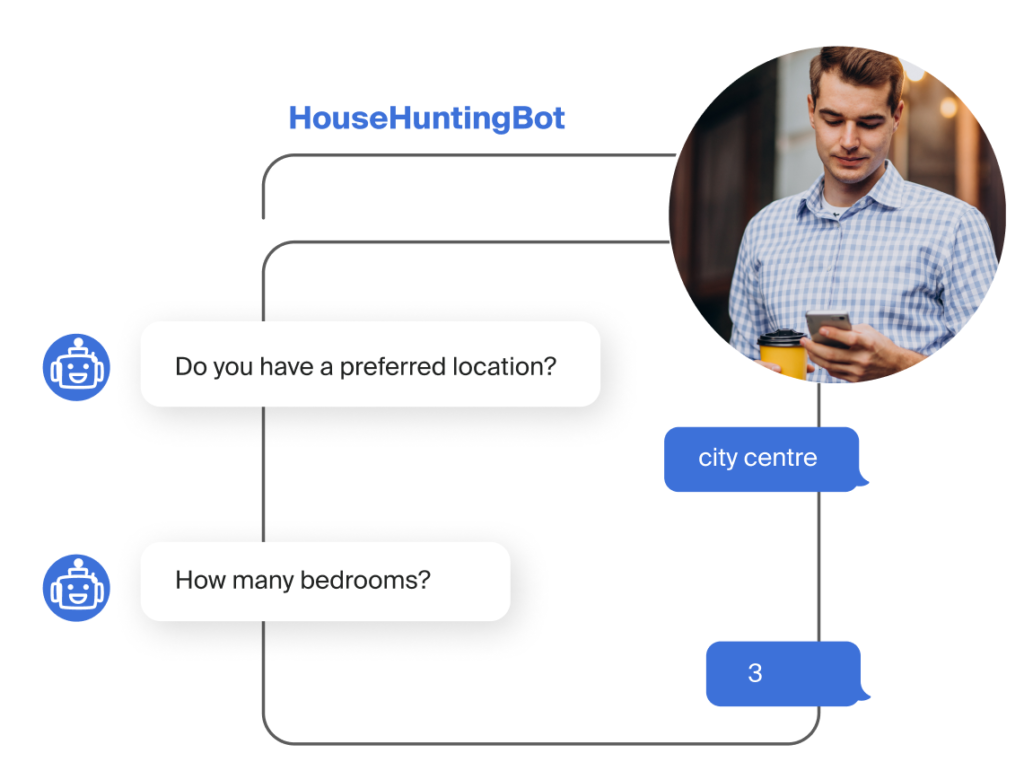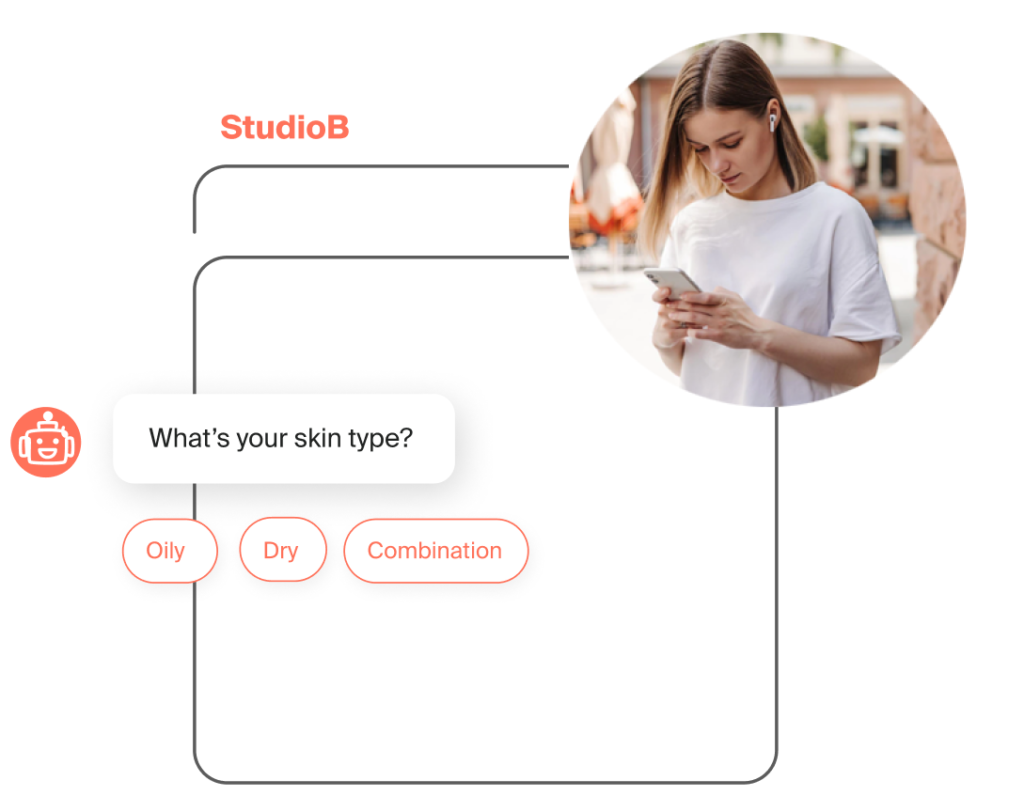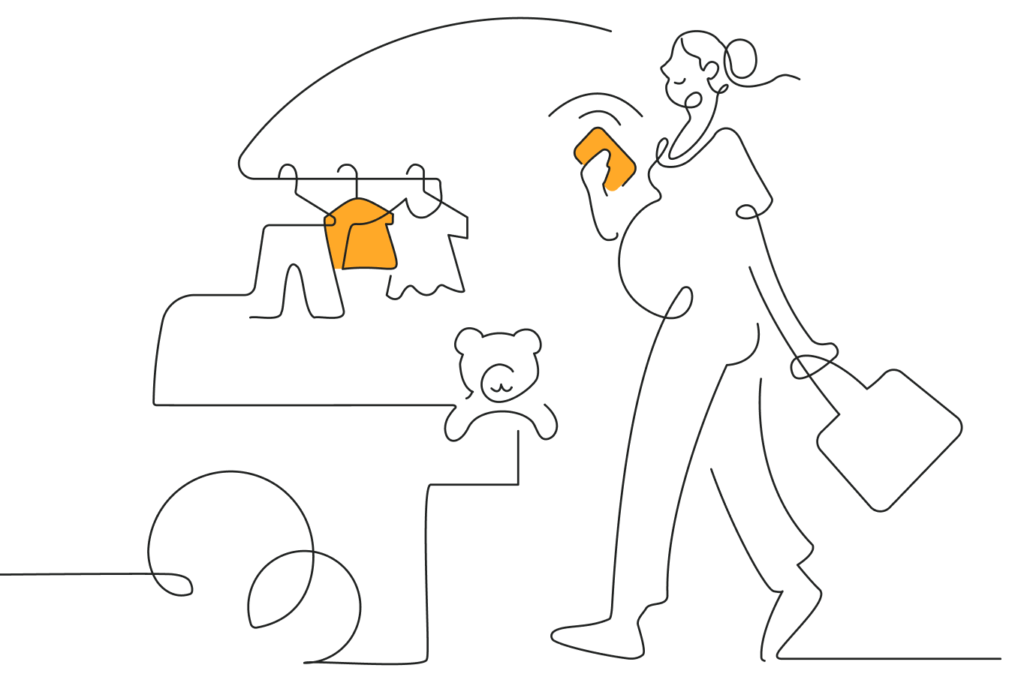If you’re thinking about investing in an AI chatbot for your retail and eCommerce business, you’ll be pleased to know that it can lead your customers through every step of your sales funnel. More than half (55%) of business leaders using chatbots say they generate high-quality leads and 47% of consumers are happy to go through the sales process with a bot. Chatbots remove friction with a consistent, cross-channel, end-to-end sales experience. AI chatbots can increase sales by 67%, so, if you’re seeking an efficient way to scale-up your sales efforts with no additional headcount, check out our suggested strategies below.
Sales Funnel Step 1: Awareness

The first time a lead lands on your website, your AI chatbot can immediately engage them in a real-time pre-sales conversation. This serves two purposes, introducing your company and gathering information to pre-qualify the lead. 36% of businesses are already generating more leads with this approach.
Take inspiration from chatbot usage in the finance sector. The best retail banks use bots to identify, qualify and match leads to products, by conversationally gleaning information about their income, expenses, and financial goals. Research shows banks can automate up to 90% of their interactions with chatbots!
Real estate businesses are successfully qualifying potential buyers, sellers and tenants online by deploying friendly chatbots that take the pain out of house-hunting. These bots ask pertinent questions about location, proximity to schools, amenities, budget, priority requirements like the number of bedrooms, and must-haves like a garden for the family dog. For 55% of buyers searching online, the most critical piece of information is a floor plan so property chatbots should always include them with personalised property shortlists.
At the same time, your bot is also filtering out unqualified leads and saving your marketing and sales department resources, time and money, which is freed up for selling to qualified leads.
Sales Funnel Step 2: Interest
At this funnel stage, prospects are delving deeper into your products and services. Your sales chatbot is on hand 24/7 on your website, WhatsApp and Facebook Messenger to serve everyone from the early bird to the night owl. 64% of customers say that 24-hour service is their favourite chatbot feature.
Imagine you’re a beauty retailer. Your goal is for your chatbot to get online visitors interested in your new range of skin care and makeup products. Your chatbot gives them a call to action to book a free makeover at your bricks and mortar store, with free testers and 10% off all purchases on the day. Once they’re in-store your trained beauty experts can quickly take them through the Evaluation, Decision and Sales processes in swift succession!
If your visitor is still just researching, your chatbot can ask questions about what makeup “look” they like. Then it provides links to relevant blog posts, eBooks, lookbooks, videos and product pages before suggesting they schedule a free makeover in their nearest store.

Sales Funnel Step 3: Evaluation
This is the point at which your prospect has shortlisted your products and want to compare them to your competitors’. 50% of shoppers use their mobile in store to compare prices and product reviews, so your bot can guide them through this process. Some businesses offer competitor comparison tables. This is particularly prevalent in SaaS eCommerce, but supermarkets also use price check tactics, and it can work for many sectors if done carefully without criticising other businesses. This is the ideal time for your bot to highlight this information your prospect.
This is also the funnel spot where chatbot hyper-personalisation rules. A recent HubSpot survey shows that 71% of people are open to receiving personalised product recommendations from businesses across all sectors. Building on the beauty example at the “Interest” level above, your chatbot can really drill down into a consumer’s preferences and provide a personal shopper or virtual stylist service. A consumer might ask your bot to recommend some running shoes. The chatbot can then ask for the shopper’s shoe size, preferred brands, as well as running style and level, then provide a customised carousel of trainer images. This increases customer satisfaction and drives sales, as consumers are more likely to purchase clothing that is comfortable, fit for purpose and suits their style. According to a study by McKinsey, 70% of consumers are interested in personalised recommendations and offers specifically for clothing and footwear.

Sales Funnel Step 4: Decision
When it comes to making a decision, your prospects will be wondering what additional value they can get. They’ll be looking at your payment, shipping, cancellations returns and refund options, processes, and Ts&Cs.
Your website chatbot is perfectly positioned to answer these questions, offer a timely discount voucher, provide links to user manuals and how to videos, or suggest an upsell product to guide the lead to the “Sale” stage.
Some consumers will want to buy online and pick up in store (BOPIS) to avoid shipping wait times or costs. Your bot can facilitate this sales process by telling them where their nearest store is and inviting them to sign up to your business messaging service so it can send them automated transactional messages about the process for picking up their product via WhatsApp or SMS. Then you have additional channels to contact them on, so you can easily keep them up to date on new products, sales, VIP and loyalty campaigns.
If your leads haven’t already looked at reviews at the “Evaluation” step, they may want to see them at the “Decision” stage. 95% of consumers read online reviews before buying and 58% say they would pay more for the products with good reviews. So, ensure your chatbots are set up to take and to display sales, marketing and customer service polls, surveys and sentiment feedback. Don’t fret about negative reviews, they’re a good PR opportunity for a public apology, a promise to do better, an offer of compensation and vital data for ongoing improvement.
Sales Funnel Step 5: Sale

Offering multiple payment options increases trust, boosts conversions and reduces cart abandonment. There were 360 million BNPL users in 2022, which is expected to rise to 900 million by 2027 and, according to Klarna, BNPL can increase conversions by 44%! Additionally, around 60% of consumers use a mobile wallet at least once a week. Choice is paramount to conversion success, so make sure your AI chatbot is well versed in all your payment plans and methods.
Another way AI chatbots can drive revenue is by providing order assistance throughout the checkout, and fulfilment process. If your lead complains to your bot about shipping costs or times, offering a discount, waiving the cost altogether or offering free shipping for a minimum spend can make all the difference. 48% of consumers will add extra items to their carts just to qualify for free shipping so programming your bot to know when to use this tactic could increase your Average Order Value (AOV). Another way to boost the AOV is for your bot to cross-sell useful products that complement what’s in your prospect’s basket.
Unliver ran a WhatsApp chatbot campaign to promote their new fabric conditioner. They put up over 1,000 billboards around Sao Paulo with a WhatsApp number for consumers to call, whereupon they were answered by a chatbot called MadameBot. The bot provided top tips on clothing care, a 50% discount on Unilever products and free shipping. As a result, Unilever received 290k WhatsApp messages, acquired 12k new customers and increased sales by 1400%!
It’s clear that chatbots can sell! Of course, you don’t just want your customer to purchase from your business once, you want them to continually repurchase from you. Make sure your chatbot strategy goes beyond the 5 standard sales funnel stages. By analysing your bots’ customer data you can program it to create personalised experiences for every customer. Remember, 91% of consumers prefer shopping with brands that recognise, remember, and provide personalised offers and recommendations.

